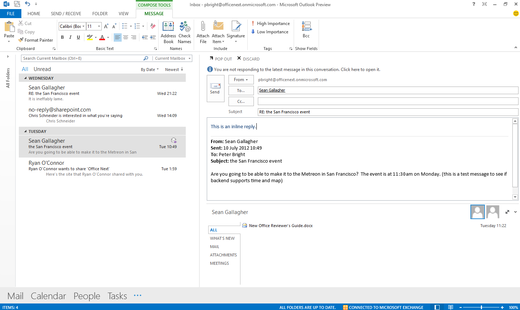Tell us about yourself - the 2012 Signal vs. Noise reader survey
Every few years, we run a survey of Signal vs. Noise readers. We hope you’ll take a few minutes to tell about yourself and what you’d like to see more of in the future.
You’re reading Signal v. Noise, a publication about the web by Basecamp since 1999. Happy !
Every few years, we run a survey of Signal vs. Noise readers. We hope you’ll take a few minutes to tell about yourself and what you’d like to see more of in the future.
Our good friends, Davey Sommers and Gwen Harley, are currently running a Kickstarter to support the opening of their locally-focused grocery and deli in Chicago.

We’re big fans of increasing accessibility to fresh and natural food products. A few months ago, Emily posted about the unique CSA benefit provided to the 37signals team. You can see this means a lot to us. Nourishing yourself with fresh, unprocessed foods translates into feeling and performing better every day. You are what you eat. /play rimshot
Part of PLENTY’s mission is to serve underrepresented diets. Sensitivity or complete intolerance to gluten is becoming increasingly common in our world of processed food. I myself gave up gluten one year ago and shops like PLENTY help take the challenge out of living gluten-free.
Just like any startup, jumping into the food business isn’t easy. Davey and Gwen can use all the help they can get to make this dream a reality. Every little bit helps in working towards their fundraising goal.
I hope they’ll inspire you to support the cause.

Back in 2003, I wrote a post about designing the blank slate. BTW: The web-based application mentioned in the post was the original version of Basecamp which wasn’t released until 2004.
The blank slate is the initial state of an application right after someone signs up. It’s blank, there’s no data, no photos, no content at all. A bad blank slate is like someone opening the door and just staring at you uncomfortably. A great blank slate is like someone opening the door, smiling, and warmly welcoming you inside.
We’ve been obsessed with the blank slate since the first version of Basecamp back in 2004. So when we designed the all new Basecamp (the 2012 version), we wanted to make sure we paid close attention to the blank slates.
We captured all the work that went into the blank slate designs in a Basecamp project called “Blank Slates”. We’ve made it entirely public so feel free to poke round. I’ll be highlighting some interesting parts below.
Here we discuss what the projects list should look like when there are no projects. We referenced the rough sketch concept we liked from Sortfolio (then called Haystack). And here’s a related discussion about what the page should look like when you have a single project, no more, no less.
Here’s a discussion we had about a “painterly-style” brush stroke on the blank slates. We saw the blank slate as an opportunity to “smile” at our customers with friendly colors and comfortable shapes. A brushstroke felt good, but we wanted to try on a few different styles.
We struggled with how a blank project should look. In fact, we didn’t come up with the final design you see today until a few weeks before launch. But, here’s a particularly meaty discussion that shows a bunch of early design concepts.
What should it look like if someone doesn’t have any to-dos? Here, Scott and I discuss a few ideas and designs.
Want to see every design, iteration, and concept we discussed? They’re all on one page in the all new Basecamp.
One of the great new features of the all new Basecamp is the ability to page through an entire project one day at a time. This is especially useful if you’re out of the office, out sick, or otherwise too occupied to pay close attention to a project every day. Just sign in to Basecamp, click the Catch Up link, and page through the days you missed.
We hope you’re enjoying these Backstage looks at how we used Basecamp to build Basecamp. We’ll try to post one a week for as many weeks as we have projects to share.
We launched the new Basecamp on March 6. Since then we’ve deployed 891 new versions with all sorts of new features, bug fixes, and tweaks. Through all of that we’ve had just six incidents of either scheduled or unscheduled downtime for a total of 19 minutes offline.
Today, that means we’ve been available 99.99% of the time since launch. That’s worth celebrating! Our fantastic operations teams consisting of Anton, Eron, John, Matt, Will, and Taylor have worked tirelessly to eliminate interruptions and they deserve our applaud.
Since we count “scheduled” downtime the same as “unscheduled” (have you ever met a customer who cared about the difference?), that has meant making good progress on stuff like database migrations.
In the past, when we focused mainly on unscheduled downtime as a measure of success, we wouldn’t think too much of taking a 30-minute window to push a major new feature. Not so these days. Thanks to Percona’s pt-online-schema-change, we’re able to migrate the database much easier without any downtime or master-slave swappero.
So three cheers to the four 9’s! Our next target is five 9’s, but that only allows for 5 minutes of downtime in a whole year, so we have our work cut out for us.
You can follow along and see how we’re doing on basecamp.com/uptime.

The Office 2013 UI, as captured by Peter Bright of Ars Technica.
or: It’s complicated until you make it simple
We’re smart people – we’ve been making collaboration software for the better part of a decade now. We live to connect people & information, no matter where in the world they are.
We’ve been having a problem that’s got us all scratching our heads. We want to have a (gasp) meeting, to present some ideas that we’ve all been working on. We’ll need to screen share, and talk to each other, and listen. All in real time. We’re scattered from Vancouver to Thailand.
We can’t figure it out. It’s the audio part that has us beat. And by ‘us’ I mean the people in the Chicago office. We can screen share, and one person can talk. But we have this great theater, full of people who can’t keep their mouths shut.
Our A/V Club reports our audio set up won’t support aggregate input devices, meaning another microphone. Our non-Chicago folks can hear the speaker, but not the audience comments. The result is pathos & fury, heads hung in failure, the stench and shame of defeat.
Here’s what we’ve tried:
- Campfire conference calls. They’re great if all you want to do is talk, which often we do. But if we need to screen share, we need something else.
- Speaker phone & screenshare via IM. Works great if there’s only one remote person. We need more people involved.
- Google Hangouts. Yup, we investigated it. Great service, but it’s limited to 10 people, unless you want a public hangout, which we don’t. (Sorry, it’s not personal)
- GoToMeeting & WebX & Join.me. GoToMeeting works great for our Basecamp classes. They’re all great if we have one speaker.
- AdobeConnect. We need an “Enterprise Specialist” to help us connect. What does that even mean?
- Meet-ups. A few times a year, everyone hitches up their wagons & moseys to Chicago to interact in person. Having everyone in one room works flawlessly, but it’s not always practical.
SvN readers, we want to pick your juicy brains. How do you do this? We’re certain this is a solved problem. We’re appealing to your benevolence & mercy.
Let’s hear it.
A few of us recently attended Velocity Conference in San Jose, CA. In the “hallway track sessions” a number people asked about the hardware that powers Basecamp, Campfire and Highrise.
Application Servers
All of our Ruby/Rails application roles run on Dell C Series 5220 servers. We chose C5220 servers because they provide high density, high performance, and low cost compute sleds at a decent cost point. The C5220 sleds replaced invidual Dell R710 servers which consumed a greater amount of power and rack space in addition to offering expandability we were not utilizing.
We use an 8 sled configuration with E31270 3.40GHz processors, 32/16G of ram, an LSI raid card and 2 non Dell SSDs. (For those of you thinking of ordering these … get the LSI raid card. The built in Intel raid is unreliable.) Each chassis with 8 sleds takes up 4U of rackspace: 3 for the chassis and 1 for cabling.
Job / Utility Servers
We use a combination of C6100 and C6220 servers to power our utility/jobs and API roles. We exclusively use the 4 sled version (of each) which means we get 4 “servers” in 2U. Each sled has 2x X5650 processors, 48-96G of ram, 2-6 ssds, and 4×1G or 1×10G network interfaces. This design allows to have up to 24 disks in a single chassis while consuming the same space as a single R710 server (which holds 8 disks max).
Search
For Solr we run R710s filled with SSDs. Each instance varies, but a common configuration is 2x E5530 processors, 48G of ram, 4-8 ssds, and 4×1g network interfaces. For Elastic Search we run a mix of Poweredge 2950 servers and C 5220 sleds with 12-16G of ram and 2×400G ssds in a raid 1.
Database and Memcache/Redis Servers
For Database roles we use R710s with 2x X5670 processors, 1.2TB Fusion-IO duo cards and varying amounts of memory. (Varies based on the database size.) We also have a number of older R710s powering Memcache and Redis instances. Each of these has has 2x E5530 processors and 2-4 disks with 4×1G network interfaces.
Storage
We have around 400TB / 9 nodes of Isilon 36 and 72NL storage. We serve all of the user uploaded content off this storage with backups to S3.
OS Choice
Database servers run RHEL or Centos 6 while application and utility servers run Ubuntu LTS.
Basecamp is pitched as a project management tool, but it’s super useful in a variety of other applications, too.
Projects aren’t just things with beginning and ends. Sometimes, a project is perpetual activity – something that starts but continues instead of ends. At 37signals we have a number of never-ending projects in Basecamp including a company “Newsroom” where we post and discuss company-wide announcements.
We started a Basecamp project to be the definitive place for designers at 37signals to share inspirational things they’ve run across. It could be great copywriting, a fantastic advertisement, an interesting animation, a beautiful object, whatever – if it inspires one of us we want to share it with all of us.
We keep these things in our Designers Clubhouse project. It’s a little project for our design team to share the things we see that make us go “wow”.
A few weeks ago Mig was putting a presentation together about the design culture at 37signals, so he posted a message in the project asking each of us a series of questions. We all responded with individual comments, and now all that feedback is gathered up in a single place, centralized and stored forever. Imagine having to keep all these answers as separate emails… What a mess! Basecamp cleans things up and keeps it all together.
We’ve made the Designers Clubhouse project public so anyone can follow along. It’s a living, breathing project so check back often to see what we’re sharing.
If you don’t have a Basecamp account, sign up today for a free 45-day unlimited trial. Take it for a spin, start up a few projects, and see just how creative you can be.